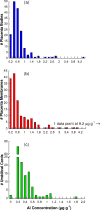A study of the distribution of aluminium in human placental tissues based on alkaline solubilization with determination by electrothermal atomic absorption spectrometry
- PMID: 21072353
- PMCID: PMC3315392
- DOI: 10.1039/c0mt00010h
A study of the distribution of aluminium in human placental tissues based on alkaline solubilization with determination by electrothermal atomic absorption spectrometry
Abstract
Aluminium (Al) is a nonessential element known to induce neurotoxic effects, such as dialysis dementia, in patients on hemodialysis, with compromised kidney function. The role of Al in the progression of some neurodegenerative diseases, such as Alzheimer's disease (AD), is controversial, and remains unclear. The effects of Al on other vulnerable populations, such as fetuses and infants, have been infrequently studied. In the present study, Al has been measured in human placenta samples, comprising ∼160 each of placenta bodies, placenta membranes, and umbilical cords, using electrothermal atomic absorption spectrometry (ETAAS) after atmospheric pressure digestion with tetramethylammonium hydroxide (TMAH) and ethylenediaminetetraacidic acid (EDTA). The sensitivity, or characteristic mass (m(0)), for Al at the 309.3-nm line was found to be 30 ± 4 pg. The instrumental detection limit (IDL) (3s) for Al in solution was calculated as 0.72 μg L(-1) while the method detection limit (MDL) (3s) was 0.25 μg g(-1). Accuracy was assessed through analysis of quality control (QC) materials, including certified reference materials (CRMs), in-house reference materials (RMs), and spike recovery experiments, of varying matrices. Placental tissue analyses revealed geometric mean concentrations of approximately 0.5 μg g(-1) Al in placenta bodies (n = 165) and membranes (n = 155), while Al concentrations in umbilical cords (n = 154) were about 0.3 μg g(-1). Al was detected in 95% of placenta bodies, and 81% of placenta membranes, but only in 46% of umbilical cords.
Figures



References
-
- Alfrey AC, Hegg A, Craswell P. Am J Clin Nutr. 1980;33:1509–1516. - PubMed
-
- Faugere MC, Arnala IO, Ritz E, Malluche HH. J Lab Clin Med. 1986;107:481–487. - PubMed
-
- Campbell A. Nephrol Dial Transplant. 2002;17(Suppl 2):17–20. - PubMed
-
- Ward RJ, Zhang Y, Crichton RR. J Inorg Biochem. 2001;87:9–14. - PubMed
Publication types
MeSH terms
Substances
Grants and funding
LinkOut - more resources
Full Text Sources

